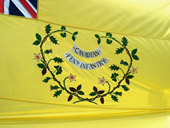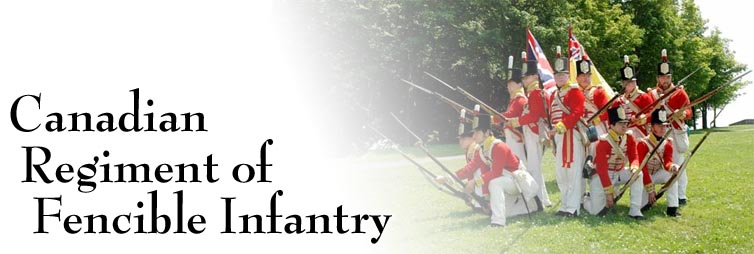Articles
|
|
|
|
History -
More History of the Canadian Fencibles
From the Fife And Drum The newsletter of the Friends of Fort York and Garrison Common v. 10 No. 1 February 2006
You can find past issues of the Friends of Fort York newsletter at http://www.fortyork.ca
In the following article David Juliusson, a Program Officer at the fort, continues the story of the Canadian Fencibles begun by Ross Flowers in the last issue of fife and drum. The Fencibles were among the first regiments to Garrison Fort York after its rebuilding in 1814-1816
A History of the Canadian Fencibles, 1803-1816
By David Juliusson
In British Army parlance of the 19th century, Fencible Regiments were units raised in Scotland, Ireland, or the colonies who were stationed locally to free up the regular Army so it could be sent elsewhere. Led by officers from the Regular Force, Fencibles were paid and trained as regulars. During the War of 1812, five such regiments served in Canada: the New Brunswick and Nova Scotia regiments, the Canadian Fencibles, Glengarries, and Royal Newfoundlanders. Only the last three saw action in Upper Canada.
The Canadian Fencibles had an inauspicious beginning. In 1803, the Passenger Act was passed limiting the number of emigrants a ship could carry, thereby frustrating thousands of Scots, most of them Highlanders, who wanted to leave for North America. Colonel Thomas Peter was given orders to recruit among them for defenses in the Canadas. When 700 man had signed on, they and their 1500 dependents where marched out of the Highlands in driving rain. Along the way they were mocked for their ragtag appearance - none had been given uniforms - and when they got to their destination in late June, 1804, they were inadequately supplied and housed. Another of their grievances was that none of their officers spoke their Gaelic language.
A short time later a rumour spread that the regiment had been sold to the East India Company, which seemed to be confirmed when the unit was ordered to the Isle of Wight, the normal embarking point for India Minor. Disturbances among the recruits broke out that culminated in rioting. In response, the War Office ordered the Canadian Fencibles disbanded but kept on the Establishment List.
The regimental officers and sergeants then we're transferred to the Canada's to start recruiting anew. Initially, they were met with mistrust by French Canadians, because the recruiters were unable to speak French, and by Scots settlers who are more likely to join the Glengarries. But the promotion of Canadian officers coupled with hard economic times fostered the regiment's growth. By November 1808 the army list shows 24 sergeants, 22 drummers, and 411 rank and file. As of June 1812 there were 700 men on strength.
A Return for the Canadian Fencibles made in 1810 provides an interesting insight into the unit's composition: 58% were Canadian-born, most of them French-speaking, 10% were Scottish, 8% Irish, and 19% foreign. A majority of the foreign-born where American, but others hailed from Prussia, Finland, Bermuda, and South America. Sixteen of the 29 sergeants were Scottish, six we're Canadian, five foreign, and two Irish.
The regiment served with distinction in various roles throughout the ensuing war. In 1812 one company served as Marines on the St. Lawrence flotillas. A second company acted as militia administrators, instructors, and artificers and assisted the Royal Artillery. In 1813 Canadian Fencibles participated in the Lake Champlain campaigns and in the defense of Montréal. The Light Company distinguished itself at the battle of Chateauguay. At Crysler's Farm, another company sustained thirty-five percent casualties in charging the enemy guns. At LaColle, when the Grenadier's were ordered to relieve the garrison, they twice charged the hostile guns.
In 1814, the Canadian Fencibles were posted to upper Canada. Some of the men did garrison duty at Kingston, while small detachments fought at Chippewa and in the Niagara campaigns. Late in the year both the Canadian Fencibles and the Glengarries we're order to Fort York to serve as the new Garrison, which is where they were when the war ended. On 15 April 1815 the York Gazette reported, "Lieut. General Sir George Murray reviewed the battalion of Canadian Fencibles now doing duty here and was pleased to express his approbation of their steady discipline and soldier-like appearance".
After the regiment was disbanded at Montréal in 1816, many of the men returned to their homes in Lower Canada. But other sought land grants in Upper Canada, particularly in the townships near the Perth Military settlement in what is now Lanark County. Captains William Marshall and Josias Taylor, Lieuts. Benjamin De Lisle and Noah Freer, Sergt. William Matheson, and Privates Joseph Legary and Louis Grenier are known to have been among these settlers.
|
|
|

|
